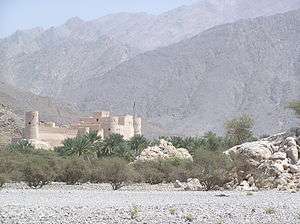Shapur II's Arab campaign
The Shapur II's Arab campaign took place in 325, against numerous Arab tribes, due to the Arab incursions into the Sasanian Empire. Shapur II decisively defeated all the Arab tribes during his campaign, and became known as Dhū al-Aktāf to the Arabs, meaning “he who pierces shoulders”.[1]
Arab incursions
During the childhood of Shapur II, Arab nomads made several incursions into the Sasanian homeland of Pars, where they raided Gor and its surroundings.[1] Furthermore, they also made incursions into Meshan and Mazun.
Shapur II's campaign
At the age of 16, Shapur II led an expedition against the Arabs; primarily campaigning against the Ayad tribe in Asoristan and thereafter he crossed the Persian Gulf, reaching al-Khatt, a region between present-day Bahrain and Qatar. He then attacked the Banu Tamim in Hajar mountains. Shapur II reportedly killed a large number of the Arab population and destroyed their water supplies by stopping their wells with sand.[2]
After having dealt with the Arabs of eastern Arabia, he continued his expedition into western Arabia and Syrian Desert, where he attacked several cities—he even went as far as Medina.[3] Because of his cruel way of dealing with the Arabs, he was called Dhū al-aktāf (Arabic: ذو الأكتاف, "he who pierces shoulders") by them.[1][4] Not only did Shapur II pacify the Arabs of the Persian Gulf, but he also pushed many Arab tribes further deep into the Arabian Peninsula. Furthermore, he also deported some Arab tribes by force; the Taghlib to Bahrain and al-Khatt; the Banu Abdul Qays and Banu Tamim to Hajar; the Banu Bakr to Kirman, and the Banu Hanzalah to a place near Hormizd-Ardashir.[1] Shapur II, in order to prevent the Arabs to make more raids into his country, ordered the construction of a defensive line near al-Hira, which became known as Wall of the Arabs (Middle Persian: war-ī tāzīgān, in Arabic: خندق سابور khandaq Sābūr).
The Zoroastrian scripture Bundahishn also mentions the Arabian campaign of Shapur II, where it says the following: "During the rulership of Shapur (II), the son of Hormizd, the Arabs came; they took Khorig Rūdbār; for many years with contempt (they) rushed until Shapur came to rulership; he destroyed the Arabs and took the land and destroyed many Arab rulers and pulled out many number of shoulders".[1]
Colonies of Persian officials and soldiers were settled along the Arabian coastlands of the Persian Gulf.[5]
References
- 1 2 3 4 5 6 Daryaee 2009.
- ↑ Frye 1983, p. 136.
- ↑ Potts 2012.
- ↑ Daryaee 2009, p. 16.
- ↑ http://www.iranicaonline.org/articles/abna-term
Sources
- Pourshariati, Parvaneh (2008). Decline and Fall of the Sasanian Empire: The Sasanian-Parthian Confederacy and the Arab Conquest of Iran. London and New York: I.B. Tauris. ISBN 978-1-84511-645-3.
- Shapur Shahbazi, A. (2005). "SASANIAN DYNASTY". Encyclopaedia Iranica, Online Edition. Retrieved 30 March 2014.
